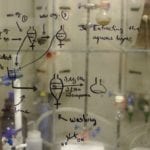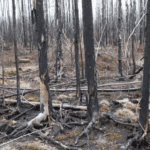Dr. Margaret-Ann Armour is a cornerstone for STEM education and gender inclusivity in Canada. A chemistry professor and Member of the Order of Canada, she dedicated 40 years to mentorship, outreach, and challenging gender-biased environments.
To celebrate Armour’s tremendous contributions, a new special issue in the Canadian Journal of Chemistry features reflections and works by those who have carried on her vision and values.

Dr. Margaret-Ann Armour at her inspirational best. | Emerson et al. (2021)
“We celebrate Margaret-Ann and build on her legacy by not being afraid to tackle the hard issues, knowing that we all benefit when inclusivity is at the centre of who we are and what we do,” says Fervone Goings, Team Lead of WISEST (Women in Scholarship, Engineering, Science, and Technology), a program co-founded by Armour in 1982.
WISEST was one of the first programs in Canada aimed at encouraging women and girls to pursue STEM careers. Co-founding WISEST was one way Armour helped address the bias against girls, which begins in childhood, continues throughout the career trajectory, and is a major driver of underrepresentation in STEM.
Today, WISEST is a thriving organisation that empowers women and other underrepresented and marginalized groups to succeed in STEM. One of their most impactful initiatives is the Summer Research Program. It immerses female and non-binary senior high school students in scientific research over one summer.
Goings and her team at the University of Alberta studied this initiative’s impact. They tracked the enrollment of 1568 students who participated in the program between 1984 and 2018. A total of 1156 students (74%) eventually attended the University of Alberta, and 971 of those students (84%) enrolled in a STEM discipline.
Higher enrollment is important, but it is not enough. What happens after enrollment is integral. Students need opportunities to develop not only critical thinking but also compassion. Dr. Armour often quoted Dr. Ursula Franklin’s words: we must “do science as if people matter”.
Reimagining the learning experience
For Dr. Leah Martin-Visscher, Assistant Professor in Chemistry at The King’s University, Franklin’s message means involving her students directly in their learning process by having them write, assess, and use Student Learning Outcomes (SLOs).
SLOs are statements that describe what a student should know, be able to do, or value at the end of a learning activity. Successfully meeting SLOs by the end of an undergraduate degree, for example, means students are well prepared to continue in the field and can readily communicate their skills and knowledge to an employer.
“SLOs can be viewed [by educators] as just lists of topics and activities to tick off for quality assurance purposes,” explains Martin-Visscher, “But with support from your institution, and with the right people—which must include students—spending the time to think about, articulate, and evaluate SLOs for your program is incredibly enriching.”
Her department invited 18 third- and fourth-year chemistry students to take part in writing and evaluating their own SLOs. They then mapped the SLOs to individual courses and decided to what extent they were being met.

Graphical abstract | Martin-Visscher et al. (2021)
They prefaced their list of SLOs with this statement:
We place the value of disciplinary knowledge within a grander story. This grander story includes our personal stories, institutional story, societal stories, historical stories, scientific stories, and more. All of these stories are important in our learning.
“As faculty, this statement was a ‘lightbulb’ moment for us,” says Martin-Visscher, “Not only did our students have a vision for what it means to be a BSc chemistry graduate, but they situated this within a context that values the experiences and stories of others and highlights their responsibility as chemists and citizens.”
The SLO model can be adapted to other STEM departments, says Martin-Visscher.
Prioritizing mentorship opportunities
For Dr. Jennifer Dengate and Dr. Annemieke Farenhorst at the University of Manitoba, doing science “as if people matter” means looking at the experience of STEM professors across Canada. Together with colleagues, they administered a workplace equity, diversity, and inclusion (EDI) survey to 700 STEM faculty members from 13 Canadian universities.
“Dr. Margaret-Ann Armour long emphasized that improving EDI within STEM fields required fixing biased systems, not the women within them. The results of our 2017–2018 Faculty Workplace Climate Survey fully support Dr. Armour’s assertion,” explains Farenhorst.
Dengate and colleagues found that STEM departments continue to be largely white, heterosexual, and male-dominated, and that women felt more gender bias than men. One way to work towards greater inclusivity is with effective mentorship, which is key to the retention and success of women researchers. Traditional pre-arranged mentorship initiatives continue to be valuable but can feel inorganic or limited if the department is small. Cross-institution mentorship or group peer-mentoring programs offer creative alternatives.
Supporting women researchers with mentorship by other women who understand their experience and can offer advice on how to combat biases can be powerful.
Indeed, Armour was a mentor at a time when the importance of diversity was not well recognized. In her early years at the University of Alberta, her colleague Dr. Gordon Freeman published a peer-reviewed article in the Canadian Journal of Physics, which stated gender-biased opinions. Thirty years later, another Canadian researcher, Dr. Tomáš Hudlický, published an article in Angewandte Chemie where he claimed EDI initiatives have a negative effect on organic synthesis research.
Dr. Imogen Coe, founding dean of Ryerson University’s Faculty of Science, examined these articles as case studies to show how pervasive bias and personal opinion can be mistaken for scientific expertise.
Although both researchers were experts in their fields of chemistry research, neither had any background or understanding of the scholarship of EDI in science. Both papers lacked adequate references and supporting data and failed to put their claims within the context of existing research.
Both papers were eventually retracted, but it is impossible to completely erase their impact. They are representative of the difficulties Armour faced and show that the peer-review system failed in both cases. The articles should never have been accepted.
Looking to the future, Coe says “…no one should be on an editorial board, or be an editor-in-chief if they don’t have core competencies in EDI—meaning that they know how to see, reduce, and/or eliminate bias and exclusion.”
To combat biases within the peer-review system, Coe recommends that scientific journals actively work towards diversity within their editorial teams. In addition, those in charge of mentoring and supervising students should be trained in cultural competencies, and all STEM graduate programs should include inclusivity training.
At the individual level, Goings* suggests reflecting on and tackling personal implicit bias, making an EDI policy available in your lab, learning how to be an ally, and creating safe spaces.
Dr. Margaret-Ann Armour had a profound impact on inclusivity and diversity in STEM. Her contributions inspired—and “continue to inspire”—EDI efforts being done today.
As Coe puts it, “She deserved better from the community in my opinion, but her legacy is significant and we are all grateful.”
—
To find all the articles in this special issue—including a new synthesis of sulfenyl dipyrroles influenced by Dr. Armour’s work—browse the Canadian Journal of Chemistry.
*Correction: A previous version of this article attributed this section to Martin-Visscher. The attribution for this section has been corrected to Goings.




